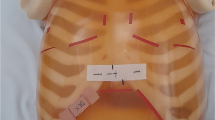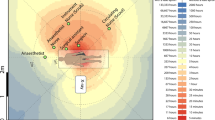Abstract
The aim of this study was to design and fabricate a thorax phantom to quantify the radiation doses to the region of the chest wall (with 3 ionization chambers), the organ at risk (OAR) (lung), and the surface using radiochromic films (EBT3) for three different 3D CRT treatment planning techniques. Anthropomorphic phantoms are one of the best tools for verifying the quality of the radiotherapy treatment plans generated by treatment planning systems since they can provide equivalent human tissue densities. Thirty acrylic plates were cut into ellipses 21 cm in height and 31 cm in width, and slots were created to insert lung equivalent cork material and bone equivalent Teflon material. Three treatment planning techniques were designed: (A) tangential pair beams, (B) tangential pair beams with wedges and (C) tangential beams followed by an anterior oblique beam. The percentage difference between the measured point doses and the calculated doses (measured with three CC13 ionization chambers) ranged from − 3.2 to 1.6%, with a mean deviation of − 1.04 ± 1.3%. The measured mean percentage doses on the target surface with EBT3 film were 90.3% and 95.1% of the prescribed dose with 5-mm and 10-mm boluses, respectively. Finally, the average absolute dose difference between the measured and calculated surface doses was within 10 cGy in all three planning techniques. The developed thorax phantom is suitable for point dose measurements using ionization chambers and for surface dose measurements using EBT3 Gafchromic films in post-mastectomy chest wall radiotherapy.





Similar content being viewed by others
References
Winslow JF, Hyer DE, Fisher RF, Tien CJ, Hintenlang DE (2009) Construction of anthropomorphic phantoms for use in dosimetry studies. J Appl Clin Med Phys 10(3):195–204
Hurwitz LM, Yoshizumi TT, Goodman PC, Frush DP, Nguyen G, Toncheva G, Lowry C (2007) Effect of dose determination using an anthropomorphic phantom and metal oxide semiconductor field effect transistor technology for the clinical adult body multi detector array computed tomography protocols. J Comput Assist Tomogr. 31(4):544–549
International Commission on Radiation Units and Measurement (1989) Tissue substitutes in radiation dosimetry and measurement. Report No. 44. Bethesda, MD: ICRU
Tieu MT, Graham P, Browne L, Chin YS (2011) The effect of adjuvant postmastectomy radiotherapy bolus Technique on local recurrence. Int J Radiat Oncol Biol Phys 81(3):165–171
Gerardina S, Edy I, Sonia S, Cristina DV, Carla Germana R, Diego G et al (2016) A new three-dimensional conformal radiotherapy (3DCRT) technique for large breast and/or high body mass index patients: evaluation of a novel fields assessment aimed to reduce extra–target-tissue irradiation. Br J Radiol 89:20160039
Vicini F, Winter K, Straube W et al (2005) A phase I/II trial to evaluate three-dimensional conformal radiation therapy confined to the region of the lumpectomy cavity for Stage I/II breast carcinoma: Initial report of feasibility and reproducibility of Radiation Therapy Oncology Group (RTOG) Study 0319. Int J Radiat Oncol Biol Phys 63:1531–1537
Hsu SH, Roberson PL, Chen Y, Marsh RB, Pierce LJ, Moran JM (2008) Assessment of skin dose for breast chest wall radiotherapy as a function of bolus material. Phys Med Biol 53:2593–2606
Vu TT, Pignol JP, Rakovitch E et al (2007) Variability in radiation oncologists’ opinion on the indication of a bolus in postmastectomy radiotherapy: an international survey. Clin Oncol 19:115–119
Holla R, Khanna D, Pillai BK, Jafar Ali KV, Renil Mon PS, Clinto CO et al (2019) An experimental slope method for a more accurate measurement of relative radiation doses using radiographic and radiochromic films and its application to megavoltage small-field dosimetry. J Med Phys 44:145–155
Kumar PS, Banerjee S, Arun Kumar ES, Srinivas C, Vadhiraja BM, Saxena PU et al (2018) In vivo dose estimations through transit signal measured with thimble chamber positioned along the central axis at electronic portal imaging device level in medical linear accelerator in carcinoma of the middle-third esophagus patients undergoing three-dimensional conformal radiotherapy. J Can Res Ther 14:300–307
ICRU Report 83 (2010) Prescribing, recording, and reporting intensity-modulated photon-beam therapy (IMRT). International Commission on Radiation Units and Measurements, Bethesda, MD
Marks LB, Ten Haken RK, Martel MK (2010) Guest editor’s introduction to QUANTEC: a users guide. Int J Radiat Oncol Biol Phys 76(3 Suppl):S1-2
Lobo D, Banerjee S, Saxena PU, Ravichandran R, Srinivas C, Putha SK et al (2019) Clinical implementation of brass mesh bolus for chest wall postmastectomy radiotherapy and film dosimetry for surface dose estimates. J Can Res Ther 15:1042–1050
Arjunan M, Sekaran SC, Sarkar B, Manikandan S (2018) A homogeneous water-equivalent anthropomorphic phantom for dosimetric verification of radiotherapy plans. J Med Phys 43:100–105
Bilge H, Cakir A, Okutan M, Acar H (2009) Surface dose measurements with GafChromic EBT film for 6 and 18MV photon beams. Phys Med 25(2):101–104
Author information
Authors and Affiliations
Corresponding author
Ethics declarations
Conflict of interest
The authors declare that they have no conflict of interest.
Additional information
Publisher's Note
Springer Nature remains neutral with regard to jurisdictional claims in published maps and institutional affiliations.
Rights and permissions
About this article
Cite this article
Lobo, D., Challapalli, S., Banerjee, S. et al. Fabrication and development of a thorax phantom to evaluate 3D CRT treatment planning techniques for post-mastectomy chest wall radiotherapy. Phys Eng Sci Med 44, 425–432 (2021). https://doi.org/10.1007/s13246-021-00992-6
Received:
Accepted:
Published:
Issue Date:
DOI: https://doi.org/10.1007/s13246-021-00992-6




